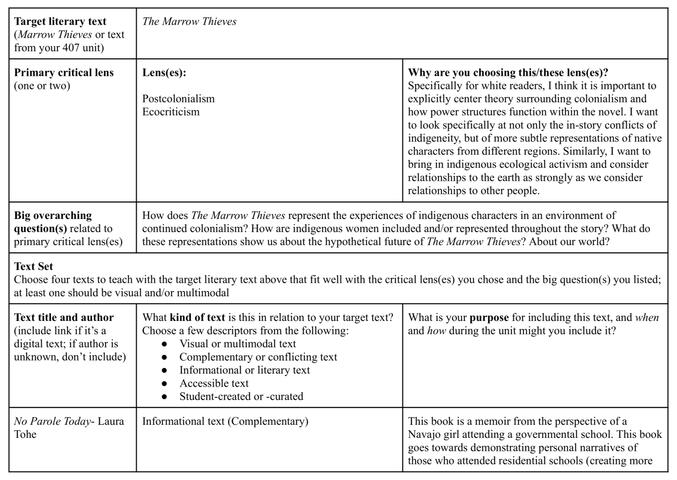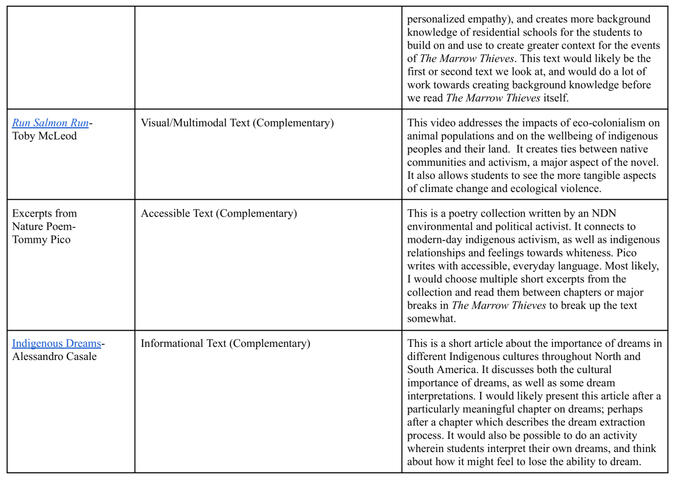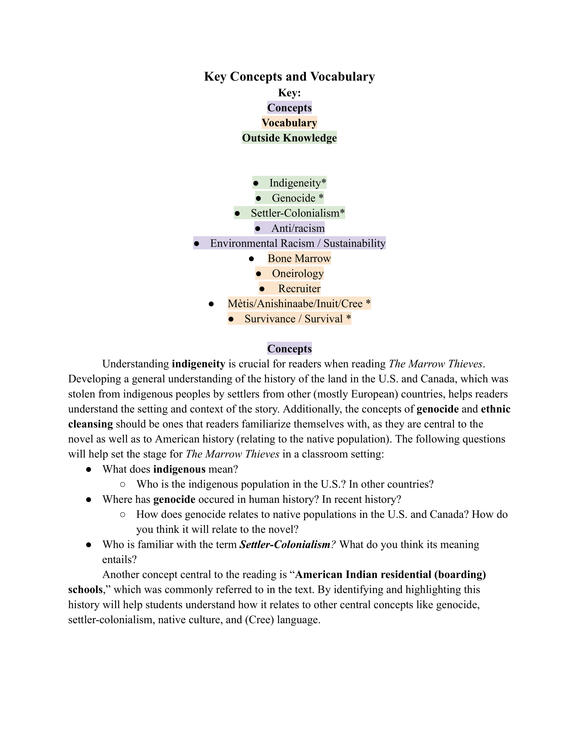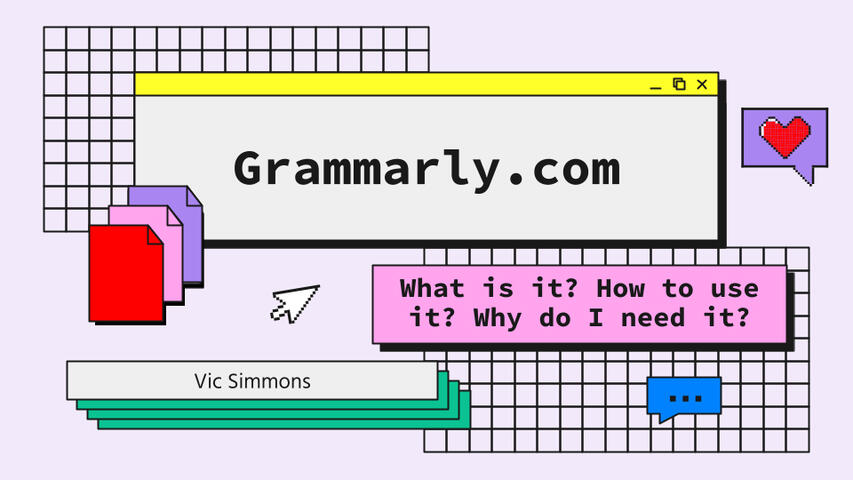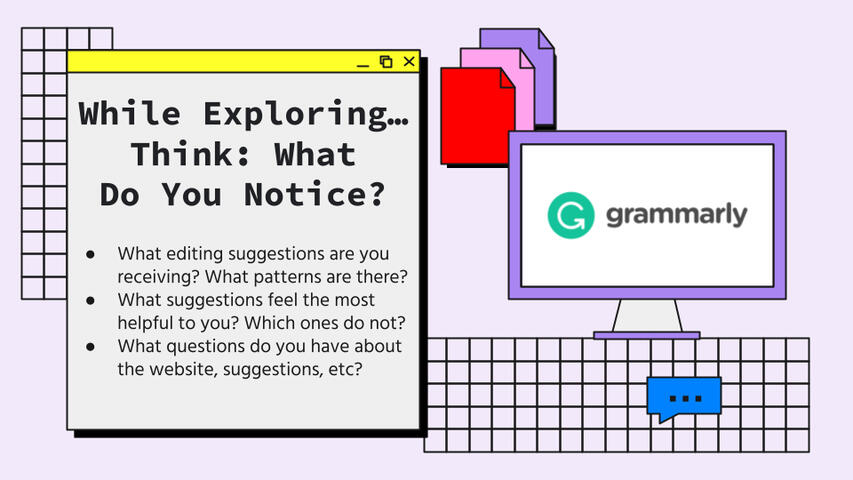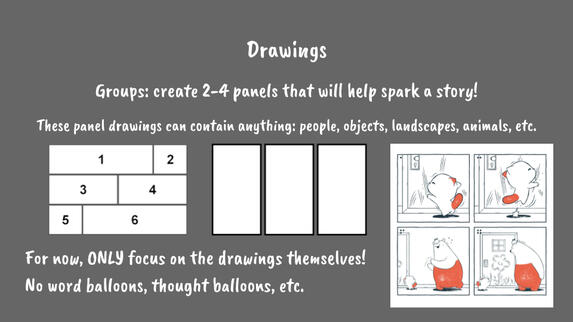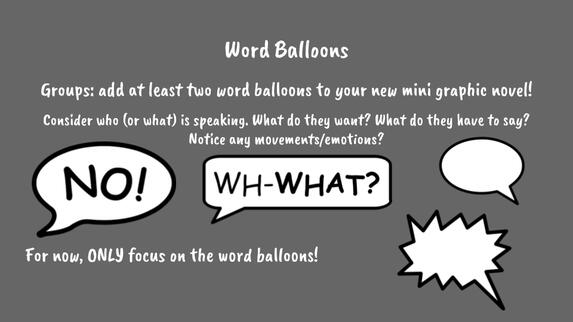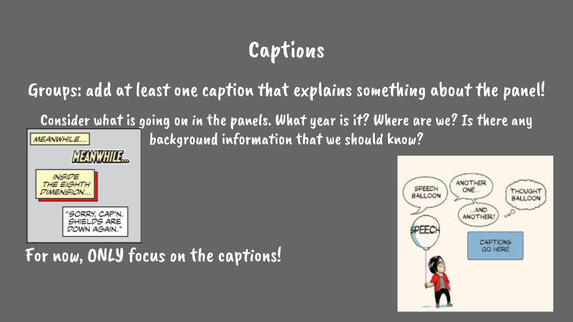Vic Simmons
Vic Simmons
they/he

Welcome!
I am a current fourth-year student within Michigan State University's Secondary English Education cohort. I have spent the last academic year working and observing within East Lansing's public school district as a student teacher.
I am most passionate about the ways in which literature and its study allow us to explore and experience emotional identities as social creatures. My focus is on providing students with authentic, emotionally-engaging education while upholding strong values of equity, diversity, and compassion.
Culturally Responsive Practices
The Marrow Thieves
Supplementary Text Set
This artifact first and foremost provides students with texts which support the overarching ideas of The Marrow Thieves, but that expand on the novel in various ways. In viewing and analyzing these forms of media alongside our focus text, students begin to draw connections between the events of the novel and the historical injustices and oppressions levelled against indigenous groups. Similarly, selected critical lenses allow us to focus our thinking about these topics and to draw conclusions based on the perspective of our chosen lens. Each text necessarily warrants analysis of its purpose, authorship, rhetorical strategies, and socio-historical contexts, and allows students practice in identifying themes, patterns, and biases that perpetuate or challenge stereotypes, injustices, and inequalities (ELA 2.f). We are responsible for thinking about why, how, and for whom these texts were written as well as the impact that these questions have on our overall interpretation and understanding. Perhaps more importantly, students naturally begin to synthesize ideas of indigeneity and the context of colonialist violence across these various texts; it becomes not a topic addressed within a single novel but one that permeates our understanding of how we as humans interact with each other.
STANDARD ELA 2.f. Guide learners in applying literary theory to critically analyze print and non print texts to identify themes, patterns, and biases that perpetuate or challenge stereotypes, injustices, and inequalities.

Emotional Analysis Summative Assessment
This artifact synthesizes the generally understood need for media literacy and textual/rhetorical analysis with the opportunity to explore emotional connections to the texts we read and to our larger social existence as humans. A small portion of the essay is devoted to textual analysis, and this analysis is driven by individual student engagement and interests. The prompt then asks students to consider a more expansive idea of emotion and how it shapes the way we understand and empathize with each other. The essay encourages students to draw parallels to their own lived experiences and to consider how these parallels may have influenced the specific pieces of textual rhetoric that they chose to analyze within the first portion of the assignment. In this way, students are able to ask and answer questions about humanity, society, their communities and/or individual lives (ELA 3.a). Students are strongly encouraged to expand on their thinking in whatever way they find most interesting and applicable, whether that results in an overarching claim or merely the consideration of deeper, more thought-provoking questions.
STANDARD ELA 3.a. Establish authentic purposes for students to read and write beyond being assigned or expected to do so, including: for their enjoyment/interest; to ask and answer questions about humanity, society, their communities and/or individual lives; to address needs in their communities and diverse communities unlike their own; or to communicate with specific audiences.
Teaching Language and Literacy
Patterns of Power: Colons Lesson
By utilizing the Patterns of Power format described by Anderson and La Roca, students are invited to notice how grammatical structures affect the way we read and understand sentences. In centering these noticings within the context of texts that we are already exploring and analyzing as a class, students are able to organically consider how sentence structures, punctuation marks, grammar differences, and other structural items are used by authors to convey meaning. This specific lesson on colon usage begins with an invitation to notice details of the example sentence. Note is taken of the colon as a separator of two individual pieces of the whole sentence. Students are almost always able to identify that the colon signals a continuation of a sort, in this instance the signifier of an upcoming list. This scaffolds knowledge of grammar functions across contexts (ELA 6.i). Because this pedagogy focuses on grammatical function over naming, students are better able to actually utilize the example structures in their own work.
STANDARD ELA 6.i. Teach grammar and sentence structure in context to guide students towards an understanding of how grammar functions across contexts and builds the necessary knowledge for reading and writing in and outside the classroom.
Key Concepts and Vocabulary
Modelled after the Disrupt Texts guide for teaching, this artifact suggests necessary vocabulary and socio-cultural concepts to accompany the teaching of The Marrow Thieves by Cherie Dimaline. These key terms are selected for instruction as central to the meaning of the text (ELA 8.d) and are broken down into three categories to assist instruction: vocabulary directly necessary to meaning-making and discussion of the text itself, knowledge of historical ideas and practices directly applicable to the content of the text, and overarching socio-cultural concepts related to but not explicitly named within the text. Activities to prompt student exploration of vocabulary are included in the recommendations. Vocabulary learning and utilization is spread throughout the reading process and is bookended by group work to solidify understanding of chosen words and the concepts/ideas they represent. This allows both students and teachers to constantly assess and re-assess understanding, and to track growing vocabulary and conceptual knowledge via students' personal dictionaries. Misconceptions can quickly be corrected by individual, group, or whole-class discussion. Similarly, these personal dictionaries and accompanying activities serve as references for later writing, either in the context of the novel itself or in the larger contexts of indigeneity and anti-racism. Similarly, the collaborative activities encourage students to identify, explore, and use new vocabulary in a variety of contexts and modes, including reading, writing, and discussion, and in print and digital texts (ELA 8.c).
STANDARD ELA 8.c. Encourage students to identify, explore, and use new vocabulary in a variety of contexts and modes, including reading, writing, and discussion, and in print and digital texts.STANDARD ELA 8.d. Select appropriate words for instruction that are central to the meaning of a text or topic and likely to generalize to other contexts.
Teaching Writing
"How-To" Grammarly Lesson
Because students have more access to online resources and texts than ever before, this artifact introduces Grammarly.com as a tool to edit and analyze our work. The full lesson walks students through navigating the website, reading and understanding feedback alerts, and making decisions about feedback utilization. This facilitates students’ use of technology and encourages decision-making appropriate to their goals (ELA 5.g). Students practice critical thinking skills that are needed to make decisions about the given feedback; they consider questions of intent, correctness, tone, and context to decide if Grammarly's suggestions will "improve" their writing. Notably, students are presented the platform of Grammarly.com but are warned against taking its feedback at face value. Priority is placed not on getting rid of each and every feedback alert, but on considering what each edit may add or subtract from their intended meaning. Students are also encouraged to utilize the goal-setting aspect of Grammarly.com, considering what tone, formality, and intent they would like their writing to convey. More than a mere proofreading website, then, Grammarly.com becomes a tool for self-reflection and analysis.
STANDARD ELA 5.g. Facilitate students’ use of technology to communicate ideas clearly and express ideas creatively for a variety of purposes by selecting the platforms, tools, styles, formats and digital media appropriate to their goals.
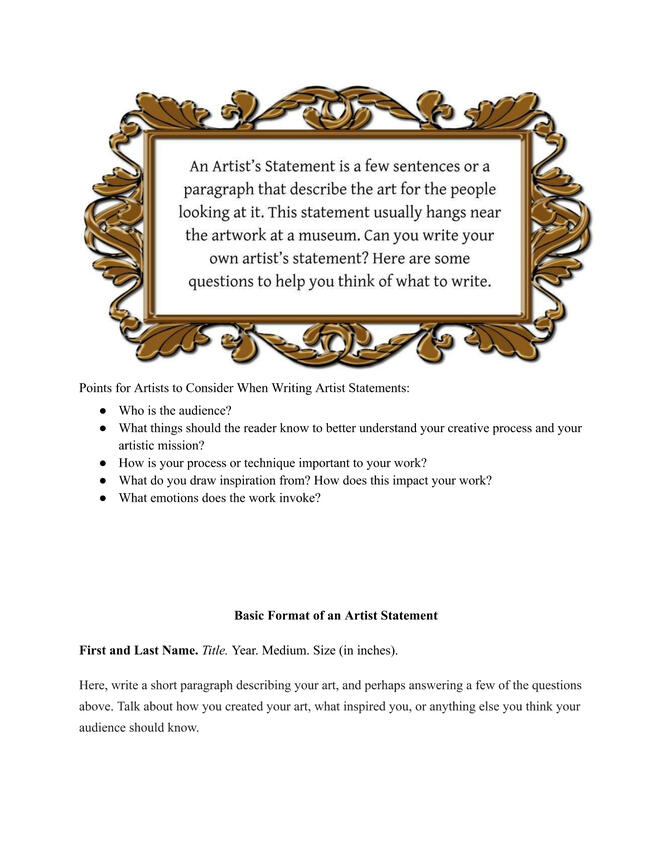
Artist Statement Writing
After creating works of art across four different mediums, this pseudo-assignment sheet walks students through the process of crafting their own artist statements: short explanations of their ideas and intentions as they worked through the art-making process. This offers a description of the characteristics of one of the various genres and text types (ELA 6.m.) that students will be exposed to throughout their lives. This specific task asks students to think of their audience as viewers of art and to consider what information is most important to an understanding of their work. The artifact addresses general expectations for both form and content when writing artist statements. It asks students to shift their thinking towards informative writing in a way that provides them an audience with whom they must walk through their artistic processes and utilize different processes and strategies (ELA 6.n) that they have previously practiced. Students have full control over which pieces of information they deem important and relevant, and are able to curate the ways in which their viewers might understand and interact with both their creations and their writing. This creates more personal significance in both the writing and presentation of students' artist statements and they serve as direct communication between student and art-viewer.
STANDARD ELA 6.m. Describe the characteristics of various genres and text types, including informational, argumentative, and narrative text; real world, digital, and academic.STANDARD ELA 6.n. Explain composition as a social and rhetorical process that serves a variety of purposes (in school and out of school) and relies on different processes and strategies.
Literary and Rhetorical Analysis
Character Mapping
This artifact prompts students to consider the innermost thoughts, wants, needs, and emotions of a given character. While reading, this character map allows us to think about literary characters as more than merely mechanisms of a story or a plot, but as individuals who share the same worries, struggles, joys, and wishes that we as readers sometimes take for granted. This mapping activity asks students to consider both what we are told as readers about a character's reactions as well as how we ourselves might think or feel in similar situations. While this certainly enhances students' textual understandings, it also allows us to consider our own shared humanity and how we understand the emotions and behaviors of others, teaching them to respect the questions, challenges, and emotions of childhood and adolescence (ELA 12.c.). There are strong opportunities for students to project their own reactions into their responses on this worksheet, and in so doing prompt further conversation and exploration within a classroom setting.

STANDARD ELA 12.c. Awareness of the power of literature to affirm lived experience, create empathy, catalyze conversations, and respect the questions, challenges, and emotions of childhood and adolescence.
Graphic Novel Workshop
This interactive graphic novel workshop served as a first introduction to some of the most important tools that graphic novelists use to communicate their ideas to readers. For this activity, each group works to add a single characteristic (drawings, word balloons/dialogue, captions, thought bubbles/internal dialogue) at a time. Each group then rotates in a circle to make additions to previous groups' work. The specific act of group rotation allows students to explore cooperative storytelling, and also allows them to see how dramatically a single change from another group can affect the entire narrative of a story. Necessarily, the rotation creates a game of "telephone" wherein each addition creates new problems, solutions, and avenues for creative storytelling. This learning activity, most importantly, introduces the typical conventions of the graphic novel meta-genre and allows them to experiment with which forms and strategies are most effective for communicating in this specific practice. This collaboration creates opportunities for students to engage in genre analysis that includes naming, describing, and modeling the conventions, strategies, and patterns of thinking that are typical of different genres (ELA 9.f.). It also provides several working classroom examples of short-form graphic novels for students to pull from as we work towards discussing how graphic novelists convey meaning.
STANDARD ELA 9.f. Create opportunities for students to engage in genre analysis that includes naming, describing, and modeling the conventions, strategies, and patterns of thinking that are typical of different genres (e.g., literary analysis, creative nonfiction, journalism, poetry, book reviews, technical documents).
